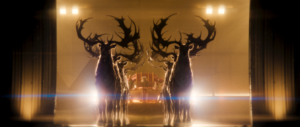Towards the Femtography of the Proton
By Garrett Farrell
At the Physics Department’s weekly colloquium on Wednesday, November 6th in Hannan Hall, Salina Ali, a Ph.D candidate in the Physics Department at Catholic University presented the research that she was performing for her doctoral thesis.
Ali’s presentation described in great detail the steps that are being used to form a 3D model of what the proton looks like, which is called a femtograph. The primary method that researchers are using in pursuit of this goal is electron-proton scattering. This process targets isolated protons using high speed electrons and records the angle between the recoil of the proton and the deflected electron that results from the collision between the two particles.
Ali’s research is done primarily at Jefferson Lab, a facility dedicated to the advancement of the science of electron-ion collisions. In recent years, Jefferson Lab has developed a state-of-the-art accelerator on site which, when properly calibrated, is capable of accurately detecting particles as small as 10^-15 meters across. To put this in perspective, one would need to line up ten-million-billion of the particles being observed at Jefferson Lab in order to create a one-meter-long line of these particles.
This research is based off of the theory of quantum chromodynamics (QCD), which posits that hadrons (subatomic particles such as protons and neutrons) consist of different combinations of three types of quarks. The theory further states that the quarks in these particles are held together by gluons, a type of boson that mediates the strong nuclear force. The component particles of a proton are so tightly bound that they can effectively treated as a solid; however, there are spaces between the quarks that are represented by a type of “sea of force.”
The QCD theory represents a concept much different from the current understanding of the proton, which was developed by Earnest Rutherford in 1911. Rutherford’s theory claims that the proton is solid throughout and is effectively a “point,” in that it is small enough that it only occupies a trivial amount of space in a simple way.
The reason that researchers are using electron scattering to develop the femtograph of the proton is that the method has proved successful in similar instances. In fact, the same method was used in the imaging of the neutron, the particle most similar to the proton in composition. Additionally, when used on the neutron, the method produced a result similar to what QCD predicts, indicating that the theory accurately describes the visual nature of subatomic particles.
According to Ali, thus far the research that she is performing is indicating results similar to those conclusions reached for the neutron. This fundamentally shifts the understanding of the structure of the proton, and is a radical departure from Rutherford’s model of the proton.
“In determining what the nature of the proton is, we are further developing our understanding of the universe, and as such we are increasing human knowledge for the better,” said Ali.








